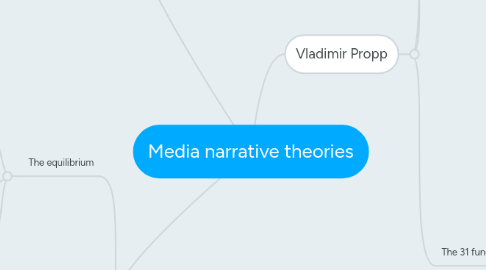
1. Tsvetan Todorov
1.1. The equilibrium
1.1.1. Todorov argued that all narratives began with a state of equilibrium where any potentially opposing forces are 'in balance'.
1.1.2. The state of equilibrium is then disrupted by some event, setting in train a series of events that drives the story.
1.1.3. The disruption is then fixed and a second different equilibrium is eventually reached, usually signalling the end of the story.
1.2. The theory
1.2.1. Although this may just seem like Todorov is claiming that every story has a beginning, middle and end it can be examined much deeper than that.
1.2.2. His theory allows us to see how a majority of films start off with an idealistic beginning before reaching a problem. This highlights the small number of films that do not follow this convention and set them apart.
1.2.3. The theory can be broken down into 5 stages
1.2.3.1. Stage 1 - Stable equilibrium
1.2.3.2. Stage 2 - Stability is disrupted
1.2.3.3. Stage 3 - Recognition of disruption
1.2.3.4. Stage 4 - Disruption is solved
1.2.3.5. Stage 5 - New harmony is formed
2. Roland Barthes
2.1. Barthes suggested that narrative works with 5 different codes which 'activate the reader to make sense of it'. The 5 different codes are the proairetic code, the hermenutic code, the connotative code, the cultural code and the symbolic code.
2.2. The 5 codes and there meaning
2.2.1. The Proairetic Code - The code of actions. Any action initiated must be completed. The cumulative actions constitute the plot events of the text. Simplified down, these drive the narrative forwards and create tension.
2.2.2. The Hermeneutic Code - The code of enigma. Puzzles will be set within the narrative to stop the audience from seeing the final outcome of the plot from the start. This code refers to any element of the narrative that is not fully explained and hence becomes a mystery to the audience.
2.2.3. The Semantic Code - The accumulation of connotations. This means that people, objects and events will have connotative aspects to create deeper meanings than the basic denotative meaning.
2.2.4. The Cultural Code - This looks at the audiences wider cultural knowledge, morality and ideology.
2.2.5. The Symbolic Code - The symbols that are given to objects (such as clothing) that can create a deeper meaning to the narrative. This is very similar to the semantic code but acts on a wider level.
3. Vladimir Propp
3.1. Propp believed that most narratives featured stock characters and functions. He based his theory off of examining hundreds of folk tales. He argued that no matter the surface of the story, that in most narratives it was possible to group characters and actions. These groups are known as 'the eight character roles' and 'the thirty-one functions'.
3.2. The 8 characters
3.2.1. 1. The villain
3.2.2. 2. The hero
3.2.3. 3. The donor (who provides an object with some form of ability)
3.2.4. 4. The helper (who aids the hero)
3.2.5. 5. The princess or damsel in distress
3.2.6. 6. The princesses father (who rewards the hero for his help)
3.2.7. 7. The dispatcher (who sends the hero on his way)
3.2.8. 8. The false hero
3.3. The 31 functions (only showing 10)
3.3.1. 1. One of the members of a family absents themselves from home (or dies)
3.3.2. 2. An interdiction is addressed to the hero
3.3.3. 3. The interdiction is violated
3.3.4. 4. The villain makes an attempt at reconnaissance
3.3.5. 5. The villain receives information about his victim
3.3.6. 6. The villain attemps to deceive his victim in order to take a possession or belonging.
3.3.7. 7. The victim submits to deception and thereby unwittingly helps his enemy
3.3.8. 8. The villain causes harm or injury to a member of a family
3.3.9. 9. The hero is approached with a request or command - he is dispatched.
3.3.10. 10. The seeker agrees or decides upon counteraction.
